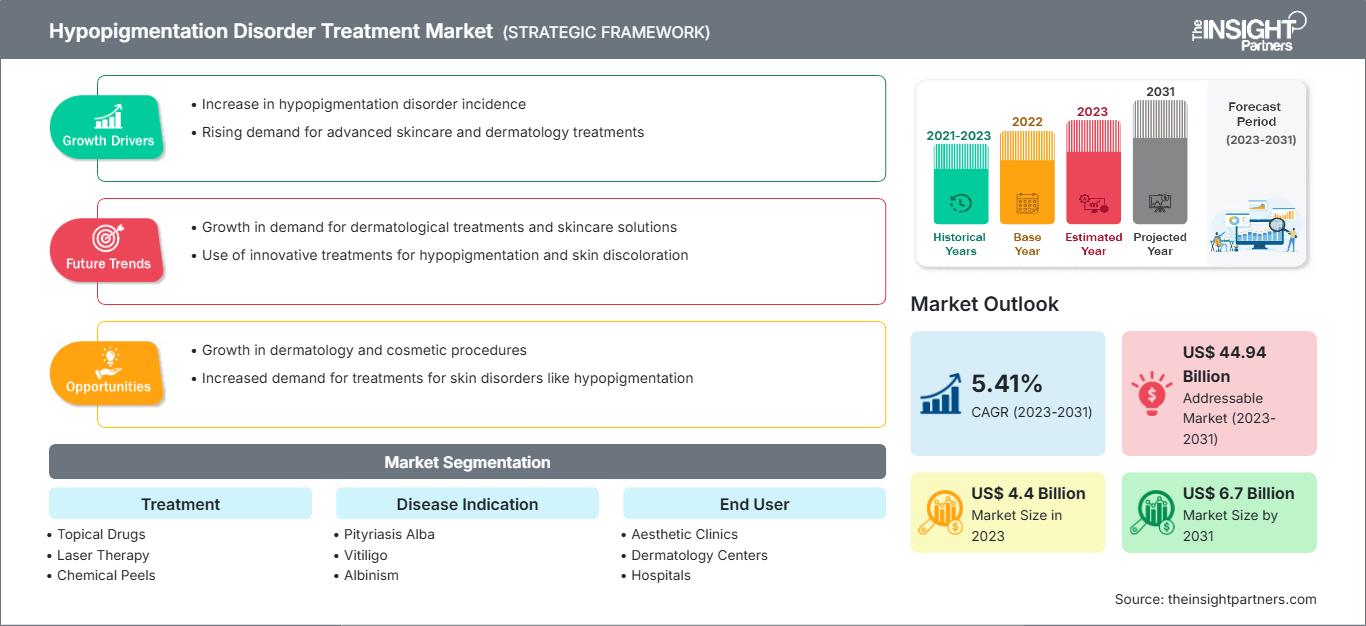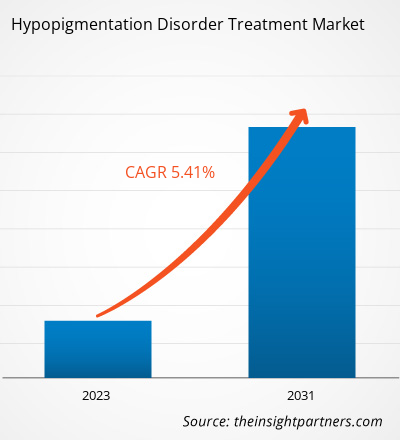[Rapport de recherche] La valeur du marché du traitement des troubles de l'hypopigmentation devrait passer de 4,4 milliards de dollars américains en 2023 à 6,7 milliards de dollars américains en 2031 ; le marché devrait enregistrer un TCAC de 5,41 % entre 2023 et 2031.
Analyses du marché et point de vue des analystes :
Les troubles de l'hypopigmentation peuvent évoluer en troubles de dépigmentation. Il s'agit d'une affection dans laquelle les niveaux de pigmentation de la peau sont inférieurs à la valeur optimale, contrairement aux états de dépigmentation qui surviennent en raison de la disparition complète des pigments. Les principaux facteurs à l'origine de la croissance du marché du traitement des troubles de l'hypopigmentation sont la sensibilisation croissante aux troubles de l'hypopigmentation, les avancées technologiques dans les traitements esthétiques et le vieillissement continu de la population. Français De plus, l'incidence croissante des troubles liés à l'hypopigmentation, tels que l'albinisme, la post-hypopigmentation et le vitiligo, devrait dynamiser le marché du traitement des troubles de l'hypopigmentation dans les années à venir. De plus, l'augmentation des dépenses de consommation pour la santé de la peau et la sensibilisation au traitement devraient bénéficier à ce marché dans un avenir proche. L'introduction de composants naturels et à base de plantes devrait orienter les tendances du marché du traitement des troubles de l'hypopigmentation dans les années à venir, car ces produits ont jusqu'à présent joué un rôle essentiel pour répondre à la demande mondiale de produits cosméceutiques. Le coût des traitements esthétiques et de la chirurgie, en revanche, limite la croissance du marché.
Selon le registre national des essais cliniques (NCT), en juin 2020, Incyte Corporation a mené un essai clinique de phase II sur le ruxolitinib afin d'évaluer son innocuité et son efficacité dans le traitement du vitiligo chez des sujets recrutés aux États-Unis. Ainsi, le nombre croissant d'essais cliniques associés aux troubles d'hypopigmentation est un autre facteur clé qui stimule le marché.
Moteurs de croissance et défis :
La prévalence croissante des troubles hypopigmentaires propulse la croissance du marché
Le pityriasis alba, le vitiligo, l'albinisme et l'hypopigmentation post-inflammatoire font partie des principales indications de maladies associées aux troubles d'hypopigmentation. Le vitiligo est une indication de maladie courante dans le monde. Selon une étude publiée dans la revue Dermatology Practical and Conceptual en décembre 2023, le vitiligo est une affection cutanée répandue qui touche les deux sexes. Néanmoins, il est plus fréquent chez les femmes et plus de 60 % des patients présentent un début de maladie avant l'âge de 30 ans. L'augmentation de l'incidence et de la prévalence du vitiligo devrait contribuer davantage à la demande croissante de traitements contre l'hypopigmentation.
Selon un article publié dans le Zagazig University Medical Journal en mars 2023, les troubles d'hypopigmentation sont un groupe courant de dermatoses en pédiatrie ; la prévalence des troubles d'hypopigmentation varie d'un pays à l'autre, allant de 3,6 % à 9,9 %. De plus, l'avènement et l'adoption de procédures mini-invasives, un temps d'admission à l'hôpital plus court et une douleur et des complications moindres associées aux procédures ont été essentiels à la popularité croissante des procédures mini-invasives. Selon l'American Society of Plastic Surgeons (ASPS), le nombre d'interventions esthétiques mini-invasives pratiquées aux États-Unis a augmenté de près de 200 % en 2021 depuis 2000. L'engouement croissant pour ces interventions stimule ainsi la croissance du marché du traitement des troubles de l'hypopigmentation. En revanche, le coût de la luminothérapie pour des pathologies telles que le vitiligo et l'albinisme est élevé. De plus, les interventions chirurgicales pour traiter le vitiligo sont très coûteuses. Ce coût élevé limite donc leur adoption, limitant ainsi la croissance du marché du traitement des troubles de l'hypopigmentation.
Vous bénéficierez d’une personnalisation sur n’importe quel rapport - gratuitement - y compris des parties de ce rapport, ou une analyse au niveau du pays, un pack de données Excel, ainsi que de profiter d’offres exceptionnelles et de réductions pour les start-ups et les universités
Marché du traitement des troubles de l'hypopigmentation: Perspectives stratégiques

-
Obtenez les principales tendances clés du marché de ce rapport.Cet échantillon GRATUIT comprendra une analyse de données, allant des tendances du marché aux estimations et prévisions.
Segmentation et portée du rapport :
L'analyse du marché du traitement des troubles de l'hypopigmentation a été réalisée en prenant en compte les segments suivants : traitement, indication de la maladie et utilisateur final. La portée géographique du rapport sur le marché du traitement des troubles de l'hypopigmentation comprend l'Amérique du Nord (États-Unis, Canada et Mexique), l'Europe (Royaume-Uni, Allemagne, France, Italie, Espagne et reste de l'Europe), l'Asie-Pacifique (Chine, Japon, Inde, Australie, Corée du Sud et reste de l'Asie-Pacifique), le Moyen-Orient et l'Afrique (Émirats arabes unis, Arabie saoudite, Afrique du Sud et reste du Moyen-Orient et de l'Afrique) et l'Afrique du Sud et du Centre. Amérique centrale (Brésil, Argentine et reste de l'Amérique du Sud et centrale).
Analyse segmentaire :
Informations basées sur le traitement
En fonction du traitement, le marché est segmenté en médicaments topiques, thérapie au laser, peelings chimiques, microdermabrasion, photothérapie et autres. Le segment des médicaments topiques détenait la plus grande part de marché du traitement des troubles d'hypopigmentation en 2023 et devrait enregistrer le TCAC le plus élevé entre 2023 et 2031.
Informations basées sur l'indication de la maladie
En fonction de l'indication de la maladie, le marché du traitement des troubles d'hypopigmentation est segmenté en pityriasis alba, albinisme, vitiligo, hypopigmentation post-inflammatoire et autres. Le segment du vitiligo détenait une part de marché significative en 2023 et devrait enregistrer le TCAC le plus élevé entre 2023 et 2031.
Informations basées sur l'utilisateur final
En termes d'utilisateur final, le marché est divisé en cliniques d'esthétique, centres de dermatologie et hôpitaux. Le segment des cliniques d'esthétique détenait la plus grande part de marché du traitement des troubles de l'hypopigmentation en 2023 ; il devrait également enregistrer le TCAC le plus élevé du marché entre 2023 et 2031.
Aperçu régional du marché du traitement des troubles de l'hypopigmentation
Les tendances régionales et les facteurs influençant le marché du traitement des troubles de l'hypopigmentation tout au long de la période de prévision ont été analysés en détail par les analystes de The Insight Partners. Cette section aborde également les segments et la géographie du marché du traitement des troubles de l'hypopigmentation en Amérique du Nord, en Europe, en Asie-Pacifique, au Moyen-Orient et en Afrique, ainsi qu'en Amérique du Sud et en Amérique centrale.
Portée du rapport sur le marché du traitement des troubles de l'hypopigmentation
| Attribut de rapport | Détails |
|---|---|
| Taille du marché en 2023 | US$ 4.4 Billion |
| Taille du marché par 2031 | US$ 6.7 Billion |
| TCAC mondial (2023 - 2031) | 5.41% |
| Données historiques | 2021-2023 |
| Période de prévision | 2023-2031 |
| Segments couverts |
By Traitement
|
| Régions et pays couverts |
Amérique du Nord
|
| Leaders du marché et profils d'entreprises clés |
|
Densité des acteurs du marché du traitement des troubles de l'hypopigmentation : comprendre son impact sur la dynamique des entreprises
Le marché du traitement des troubles de l'hypopigmentation connaît une croissance rapide, portée par une demande croissante des utilisateurs finaux, due à des facteurs tels que l'évolution des préférences des consommateurs, les avancées technologiques et une meilleure connaissance des avantages du produit. Face à cette demande croissante, les entreprises élargissent leur offre, innovent pour répondre aux besoins des consommateurs et capitalisent sur les nouvelles tendances, ce qui alimente la croissance du marché.

- Obtenez le Marché du traitement des troubles de l'hypopigmentation Aperçu des principaux acteurs clés
- Analyse historique (2 ans), année de base, prévision (7 ans) avec TCAC
- Analyse PEST et SWOT
- Taille du marché Valeur / Volume - Mondial, Régional, Pays
- Industrie et paysage concurrentiel
- Ensemble de données Excel
Rapports récents
Témoignages
Raison d'acheter
- Prise de décision éclairée
- Compréhension de la dynamique du marché
- Analyse concurrentielle
- Connaissances clients
- Prévisions de marché
- Atténuation des risques
- Planification stratégique
- Justification des investissements
- Identification des marchés émergents
- Amélioration des stratégies marketing
- Amélioration de l'efficacité opérationnelle
- Alignement sur les tendances réglementaires






















 Obtenez un échantillon gratuit pour - Marché du traitement des troubles de l'hypopigmentation
Obtenez un échantillon gratuit pour - Marché du traitement des troubles de l'hypopigmentation